Solutions and colloids Study guides, Class notes & Summaries
Looking for the best study guides, study notes and summaries about Solutions and colloids? On this page you'll find 387 study documents about Solutions and colloids.
All 387 results
Sort by
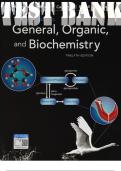 Popular
Popular
-
TEST BANK for Introduction to General, Organic and Biochemistry, 12th Edition, by Bettelheim, Brown, Campbell &Torres. (All 31 Chapters Complete Download)
- Other • 929 pages • 2024
-
- $29.49
- 2x sold
- + learn more
TEST BANK for Introduction to General, Organic and Biochemistry, 12th Edition, Frederick A. Bettelheim, William H. Brown, Mary K. Campbell, Shawn O. Farrell, Omar Torres. All 31 Chapters (Complete Dow nload). Table of Contents 1. Matter, Energy, and Measurement. 2. Atoms. 3. Chemical Bonds. 4. Chemical Reactions. 5. Gases, Liquids, and Solids. 6. Solutions and Colloids. 7. Reaction Rates and Chemical Equilibrium. 8. Acids and Bases. 9. Nuclear Chemistry. 10. Organic Chemistry. 11. Alkanes. 12. A...
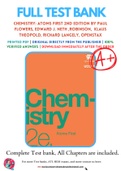
-
Test Bank for Chemistry: Atoms First 2nd Edition by Paul Flowers, Edward J. Neth ,Robinson, Klaus Theopold, Richard Langely, OpenStax Chapter 1-21 Complete Guide.
- Exam (elaborations) • 101 pages • 2022
-
- $20.41
- 3x sold
- + learn more
Test Bank for Chemistry: Atoms First 2nd Edition by Paul Flowers, Edward J. Neth ,Robinson, Klaus Theopold, Richard Langely, OpenStax Chapter 01: Essential Ideas Chapter 02: Atoms, Molecules, and Ions Chapter 03: Composition of Substances and Solutions Chapter 04: Stoichiometry of Chemical Reactions Chapter 05: Thermochemistry Chapter 06: Electronic Structure and Periodic Properties of Elements Chapter 07: Chemical Bonding and Molecular Geometry Chapter 08: Advanced Theo...
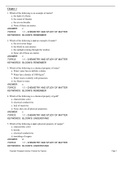
-
Test Bank for Introduction to General, Organic and Biochemistry, 12th Edition by Bettelheim
- Exam (elaborations) • 928 pages • 2022
-
- $39.99
- 11x sold
- + learn more
Test Bank for Introduction to General, Organic and Biochemistry 12e 12th Edition by Frederick A. Bettelheim; William H. Brown; Mary K. Campbell; Shawn O. Farrell; Omar Torres. ISBN-13: 1594 Full Chapters test bank Chapter 1: Matter, Energy, and Measurement 1.1 Chemistry and the Study of Matter 1.2 The Scientific Method 1.3 Reporting Numbers in Science 1.4 Making Measurements 1.5 Unit Conversions 1.6 States of Matter 1.7 Density and Specific Gravity 1.8 Describing the Various For...
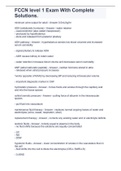
-
FCCN level 1 Exam With Complete Solutions.
- Exam (elaborations) • 13 pages • 2022
-
- $13.99
- 4x sold
- + learn more
minimum urine output for adult 0.5mL/kg/hr ADH (antidiuretic hormone) - water retainer - vasoconstrictor (also called Vasopressin) - produced by hypothalamus - store and released from posterior pituitary ADH pathway - hypothalamus senses low blood volumed and increased serum osmolality - signal pituitary to release ADH - ADH causes kidney to retain water - water retention increases blood volume and decreases serum osmolality ANP (atrial natriuretic peptide) -...
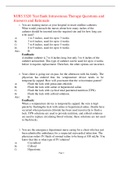
-
NURS 3320 Test Bank Intravenous Therapy Questions and Answers and Rationale,100% CORRECT
- Exam (elaborations) • 23 pages • 2022
-
- $15.99
- 1x sold
- + learn more
NURS 3320 Test Bank Intravenous Therapy Questions and Answers and Rationale 1. You are training nurses at your hospital to insert midline catheters. What would you teach the nurses about how many inches of the catheter should be inserted into the required site and for how long can it be used? A) 1 to 3 inches, used for up to 3 weeks B) 3 to 6 inches, used for up to 4 weeks C) 7 to 8 inches, used for up to 5 weeks D) 8 to 9 inches, used for up to 6 weeks Ans: B Feedback: A midline cathete...
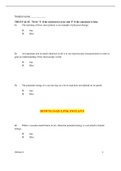
-
Test Bank for Chemistry: The Molecular Nature of Matter and Change, 9th Edition by Martin Silberberg
- Exam (elaborations) • 30 pages • 2022
-
- $35.49
- 1x sold
- + learn more
Test Bank for Chemistry: The Molecular Nature of Matter and Change 9e 9th Edition by Martin Silberberg. ISBN-13: 0214 Full chapters test bank PDF 1 Keys to the Study of Chemistry: Definitions, Units, and Problem Solving 2 The Components of Matter 3 Stoichiometry of Formulas and Equations 4 Three Major Classes of Chemical Reactions 5 Gases and the Kinetic-Molecular Theory 6 Thermochemistry: Energy Flow and Chemical Change 7 Quantum Theory and Atomic Structure 8 Electron Conf...
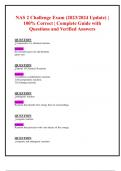
-
NAS 2 Challenge Exam (2023/2024 Update) | 100% Correct | Complete Guide with Questions and Verified Answers
- Exam (elaborations) • 43 pages • 2023
-
Available in package deal
-
- $10.99
- + learn more
NAS 2 Challenge Exam (2023/2024 Update) | 100% Correct | Complete Guide with Questions and Verified Answers QUESTION Components of a chemical reaction Answer: the reactants (goes in) and products (goes out) QUESTION Patterns of Chemical Reactions Answer: 1) Synthesis (combination) reactions 2) Decomposition reactions 3) Exchange reactions QUESTION endergonic reaction Answer: Reaction that absorbs free energy from its surroundings. QUESTIO...
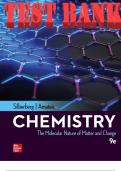
-
TEST BANK for Chemistry: The Molecular Nature of Matter and Change. 9th Edition by Martin Silberberg and Patricia Amateis. All Chapters 1-24 (Complete Download).
- Other • 710 pages • 2023
-
- $25.99
- + learn more
TABLE OF CONTENTS 1 Keys to the Study of Chemistry: Definitions, Units, and Problem Solving 2 The Components of Matter 3 Stoichiometry of Formulas and Equations 4 Three Major Classes of Chemical Reactions 5 Gases and the Kinetic-Molecular Theory 6 Thermochemistry: Energy Flow and Chemical Change 7 Quantum Theory and Atomic Structure 8 Electron Configuration and Chemical Periodicity 9 Models of Chemical Bonding 10 The Shapes of Molecules 11 Theories of Covalent Bonding 12 Intermolecular Forces: L...
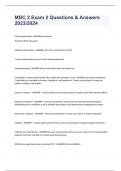
-
MDC 2 Exam 2 Questions & Answers 2023/2024
- Exam (elaborations) • 31 pages • 2023
-
Available in package deal
-
- $12.99
- + learn more
MDC 2 Exam 2 Questions & Answers 2023/2024 Fully compensated - ANSWER-pH normal PaCO2 & HCO3 abnormal partial compensation - ANSWER--pH, CO2, and HCO3 are all off -some compensation occurs but pH remains abnormal Uncompensated - ANSWER-pH and one other value are abnormal. Crystalloids- contain small particles that easily pass through a semi - ANSWER-permeable membrane. Crystalloids are classified as isotonic, hypotonic, and hypertonic. Choice for treatment is based on patient c...
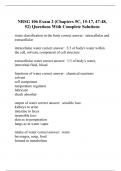
-
NRSG 106 Exam 2 (Chapters 5C, 15-17, 47-48, 52) Questions With Complete Solutions
- Exam (elaborations) • 25 pages • 2023
-
Available in package deal
-
- $12.99
- + learn more
water classification in the body correct answer: intracellular and extracellular intracellular water correct answer: 2/3 of body's water within the cell, solvent, component of cell structure extracellular water correct answer: 1/3 of body's water, interstitial fluid, blood functions of water correct answer: chemical reactions solvent cell component temperature regulator lubricant shock absorber output of water correct answer: sensible loss: kidneys to urine intestine to...

Study stress? For sellers on Stuvia, these are actually golden times. KA-CHING! Earn from your study resources too and start uploading now. Discover all about earning on Stuvia


